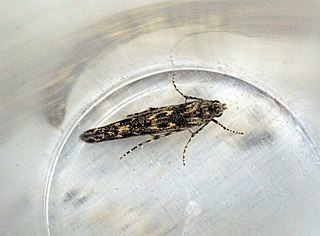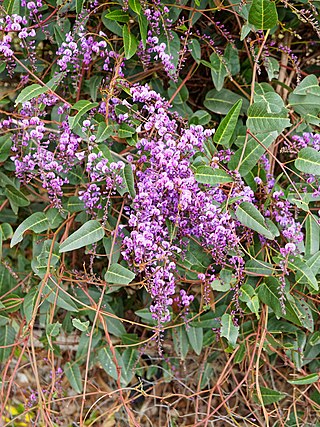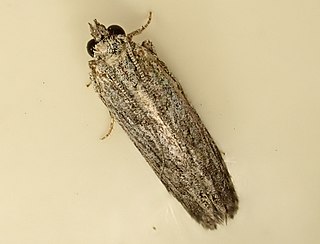
Gracillariidae is an important family of insects in the order Lepidoptera and the principal family of leaf miners that includes several economic, horticultural or recently invasive pest species such as the horse-chestnut leaf miner, Cameraria ohridella.

Batrachedra is the largest genus in the moth family Batrachedridae, with representatives all over the world. The early stages of most species are unknown. The genus name is derived from the Greek words batrachos, 'frog', and edra, 'seat', referring to the frog-like resting posture of the adult moths. As of 2018 at least some 114 species are known to belong to the genus.

Hardenbergia is a genus of three species of flowering plants in the pea family, Fabaceae and is endemic to Australia. Plants in this genus are climbing or trailing herbs or subshrubs with pinnate leaves with one, three or five leaflets and groups of violet, white or pinkish flowers in pairs or small clusters in leaf axils. Species of Hardenbergia occur in all Australian states and in the Australian Capital Territory.

Hardenbergia violacea is a species of flowering plant in the family Fabaceae and is endemic to Australia. It is known in Australia by the common names false sarsaparilla, purple coral pea, and waraburra. Elsewhere it is also called purple twining-pea, vine-lilac, and wild sarsaparilla. It is a prostrate or climbing subshrub with egg-shaped to narrow lance-shaped leaves and racemes of mostly purple flowers.

The European oak leaf-miner or Zeller's midget is a moth of the family Gracillariidae. It is found in Europe south of the line running from Ireland, through Great Britain, Denmark to Ukraine. It is also found in Macaronesia. It is an introduced species in New Zealand and Australia.
Acrocercops autadelpha is a moth of the family Gracillariidae. It is known from New South Wales and Queensland, Australia.

Acrocercops chionosema is a moth of the family Gracillariidae. It is known from Queensland and New South Wales, Australia.
Acrocercops laciniella is a moth of the family Gracillariidae. In Australia, it is known from the states of New South Wales, Queensland, Victoria, South Australia and Tasmania. It is also known from India and has recently been found in New Zealand.
Aspilapteryx tessellata is a moth of the family Gracillariidae. It is known from New South Wales, Australia. It has been recommended that this species be further studied as its placement within the genus Aspilapteryx is in need of clarification.
Caloptilia xanthopharella is a moth of the family Gracillariidae. It is known from Australia, Fiji, the Solomon Islands and Vanuatu.
Caloptilia octopunctata is a species of moth of the family Gracillariidae. It is known from the Democratic Republic of Congo, Tanzania, Uganda, South Africa, India, Australia, New Zealand and Indonesia.

Epicephala colymbetella is a moth of the family Gracillariidae. It is known from the states of New South Wales and Queensland in Australia.
Gibbovalva quadrifasciata is a moth of the family Gracillariidae. It is known from Australia, China, India, Java, Japan, Myanmar, Sri Lanka and Taiwan.
Macarostola ida is a moth of the family Gracillariidae. It is known from Australia in the states of New South Wales, Queensland, Western Australia and Victoria. In 2019 it was discovered to have become established in Northland and east Auckland in New Zealand.
Parectopa toxomacha is a moth of the family Gracillariidae. It is known from New South Wales, Australia.
Phyllonorycter stephanota is a moth of the family Gracillariidae. It is known from New South Wales and Queensland in Australia.

Porphyrosela aglaozona is a moth of the family Gracillariidae. It is known in Australia in the states of New South Wales, Queensland and Victoria and on Fiji.
Porphyrosela hardenbergiella is a moth of the family Gracillariidae. It is known from New Zealand, but may be adventive, since the host plant is Australian. The colony known to Wise has been destroyed since its discovery. This species was last collected in New Zealand in 1955 but as at 2019 was still not known from Australia.

Anarsia dryinopa is a moth of the family Gelechiidae. It is known from Australia and the warmer regions of New Zealand in both the North and the South Islands.

Gracillariinae are a subfamily of moths which was described by Henry Tibbats Stainton in 1854.








